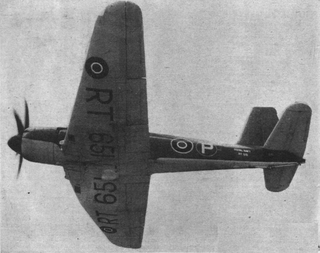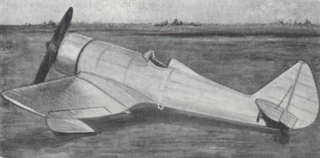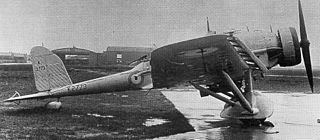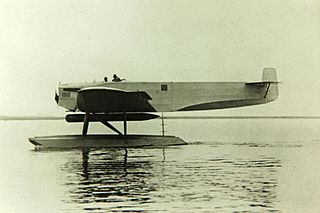
The Douglas Y1B-7 was a 1930s American bomber aircraft. It was the first US monoplane given the B- 'bomber' designation. The monoplane was more practical and less expensive than the biplane, and the United States Army Air Corps chose to experiment with monoplanes for this reason. At the time the XB-7 was ordered, it was being tested by Douglas Aircraft as an observational plane.

The Westland Walrus was a British spotter/reconnaissance aircraft built by Westland Aircraft.

The Blackburn B.48 Firecrest, given the SBAC designation YA.1, was a single-engine naval strike fighter built by Blackburn Aircraft for service with the British Fleet Air Arm during the Second World War. It was a development of the troubled Firebrand, designed to Air Ministry Specification S.28/43, for an improved aircraft more suited to carrier operations. Three prototypes were ordered with the company designation of B-48 and the informal name of "Firecrest", but only two of them actually flew. The development of the aircraft was prolonged by significant design changes and slow deliveries of components, but the determination by the Ministry of Supply in 1946 that the airframe did not meet the requirements for a strike fighter doomed the aircraft. Construction of two of the prototypes was continued to gain flight-test data and the third was allocated to strength testing. The two flying aircraft were sold back to Blackburn in 1950 for disposal and the other aircraft survived until 1952.

The Junkers J 1, nicknamed the Blechesel, was an experimental monoplane aircraft developed by Junkers. It was the first all-metal aircraft in the world. Manufactured early on in the First World War, an era in which aircraft designers relied largely on fabric-covered wooden structures braced with wires, the J 1 was a revolutionary development in aircraft design, making extensive use of metal in its structure as had already been done and in its outer surface.

The Westland Widgeon was a British light aircraft of the 1920s. A single-engined parasol monoplane, the Widgeon was built in small numbers before Westland abandoned production in 1929.

The Westland Interceptor was a fighter developed by the British company Westland Aircraft to Air Ministry Specification F.20/27. When tested in 1929 and 1930, it showed unsatisfactory handling characteristics and was rejected by the RAF in favour of the Hawker Fury biplane fighter.

The IAR 15 was a low-wing monoplane fighter designed in Romania in 1933.
The Gnosspelius Gull was a 1920s British experimental ultra-light monoplane designed by Major O.T. Gnosspelius and built by Short Brothers at Rochester for the 1923 Lympne light aircraft trials.

The Vickers Type 151 Jockey was an experimental low-wing monoplane interceptor fighter powered by a radial engine. It was later modified into the Type 171 Jockey II, which had a more powerful engine and detail improvements. Only one was built; it was lost before its development was complete, but the knowledge gained enabled Vickers to produce the more refined Venom.

The Westland F.7/30 was a British fighter prototype. A single prototype was built in 1934, but the type was not put in production because its performance fell far below the RAF's requirements. The Gloster Gladiator won the F.7/30 competition.

The Miles M.13 Hobby was a small low-winged monoplane built for racing and research in the United Kingdom just before World War II. A single engined single seater, it ended its days in the wind tunnel at the R.A.E.

The Handley Page H.P.47 was a British single-engined low-wing monoplane built to an Air Ministry specification for a general-purpose bomber and torpedo bomber aircraft. Only one was built.
Miles M.26 was the designation used to cover the family of X-series design proposals, for long-range transport aircraft. The common factors of most X design proposals were the use of a blended wing body and engines buried in the wings, based on principles patented by Nicolas Woyevodsky. A sub-scale prototype of the X.9 proposal was constructed, designated the Miles M.30.
The Westland PV.7 was a private venture submission to a 1930s British specification for a general-purpose military aircraft with two crew. It was a single-engined, high-wing monoplane of promise, but was destroyed early in official tests.
The Junkers J 15 was an all-metal monoplane built in Germany in 1920 to explore the design parameters of small single-engined passenger transports. In particular, it could fly in either high or low wing configurations. It led to the Junkers J 16 light airliner.
The Junkers J 29 was a two-seat, single-engined experimental training monoplane, built in Germany in 1925. Its significance is that it was the first aircraft to fly and test the Junkers Doppelflügel control surfaces used very successfully on the later Junkers Ju 52.

The Dyle et Bacalan DB-10 was a heavy night bomber, designed in France and flown in 1926. It was a twin engine, high wing, metal frame monoplane, distinguished by a very thick centre section wing which formed the forward fuselage and housed the engines.
The IAR 13 is a Romanian low-wing monoplane fighter-trainer aircraft designed before World War II.

The Fokker T.III or T.3 was a single engine floatplane designed in the Netherlands in the early 1920s as a bomber or torpedo bomber.
The MIP Smyk, MIP from the initials of its Polish designers with Smyk meaning Brat or Kid, was an aerodynamically refined motor glider designed and built at Warsaw Technical University from 1935.













